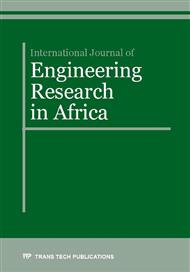[1]
Fatemi, L. Yang, Cumulative fatigue damage and life prediction theories: a survey of the state of the art for homogeneous materials, Int. J. Fatigue 20 (1) (1998) 9–34.
DOI: 10.1016/s0142-1123(97)00081-9
Google Scholar
[2]
M.A. Miner, Cumulative damage in fatigue, J. Appl. Mech. 67 (1945) A159–A164.
Google Scholar
[3]
S. S. Manson, G. R. Halford, Practical Implementation of the Double Linear Damage Rule and Damage Curve Approach for Treating Cumulative Fatigue Damage, Int. J. Fracture 17 (1981) 169-192.
DOI: 10.1007/bf00053519
Google Scholar
[4]
T. Bui-Quoc, Cumulative Damage with Interaction Effect due to Fatigue Under Torsion Loading, Experimental Mechanics, (1982) 180-187.
DOI: 10.1007/bf02327403
Google Scholar
[5]
M.A. McGaw, S. Kalluri, D. Moore, and J. Heine, The Cumulative Fatigue Damage Behavior of Mar-M 247 in Air and High Pressure Hydrogen, " In: M. R. Mitchell and R. W. Landgraf, (Eds. ), ASTM STP 1211, Advances in Fatigue Lifetime Predictive Techniques: Second Volume, 1993, pp.117-131.
DOI: 10.1520/stp15081s
Google Scholar
[6]
G. R. Halford, Cumulative fatigue damage modeling - crack nucleation and early growth, Int. J. Fatigue 19 (1) (1997) pp.253-260.
DOI: 10.1016/s0142-1123(97)00048-0
Google Scholar
[7]
G. Mesmacque, S. Garcia, A. Amrouche, C. Rubio-Gonzalez, Sequential law in multiaxial fatigue: a new damage indicator, Int. J. Fatigue 27(4) (2005) 461–467.
DOI: 10.1016/j.ijfatigue.2004.08.005
Google Scholar
[8]
A. Aid, J. Chalet, A. Amrouche, G. Mesmacque, M. Benguediab. A new damage indicator: from blocks loading to random loading. Fatigue Design Conf. (16–18 November); 2005. Paris, France.
Google Scholar
[9]
F. Ellyin, A criterion for fatigue under multiaxial states of stress. Mechanics Research Communications1(4) (1974) 219–224.
DOI: 10.1016/0093-6413(74)90068-8
Google Scholar
[10]
F. Ellyin, Cyclic strain energy as a criterion for multiaxial fatigue failure. In: Miller KJ, Brown MW, editors. Biaxial and Multiaxial. Fatigue, EGF3. London: MEP, 1989: p.571–83.
Google Scholar
[11]
F. Ellyin, K. GoŁos, Multiaxial fatigue damage criterion. Trans ASME JEMT 110 (1988) 63–8.
Google Scholar
[12]
D.F. Socie, Multiaxial fatigue damage models. Trans ASME JEMT 109(1987) 293–8.
Google Scholar
[13]
K.N. Smith, P. Watson, T.H. Topper, A stress-strain function for the fatigue of metals, Journal of Materials 5(4) (1970) 767–76.
Google Scholar
[14]
T. Łagoda, E. Macha, W. Bedkowski, A critical plane approach based on energy concepts: Application to biaxial random tension-compression high-cycle fatigue regime, Int. J. Fatigue 21(5) (1999) 431–43.
DOI: 10.1016/s0142-1123(99)00003-1
Google Scholar
[15]
T. Łagoda, E. Macha, Generalization of energy multiaxial cyclic fatigue criteria to random loadings. In: S. Kalluri, P.J. Bonacuse, editors. Multiaxial fatigue and deformation: testing and prediction, ASTM STP 1387. West Conshohocken, PA: American Society for Testing and Materials; 2000. p.173.
DOI: 10.1520/stp13504s
Google Scholar
[16]
T. Łagoda, Energy models for fatigue life estimation under random loading-part I-the model elaboration, Int. J. Fatigue 23(6) (2001) 467–80.
DOI: 10.1016/s0142-1123(01)00016-0
Google Scholar
[17]
T. Łagoda, Energy models for fatigue life estimation under random loading-part II-verification of the model, Int. J. Fatigue 23(6) (2001) 481–9.
DOI: 10.1016/s0142-1123(01)00017-2
Google Scholar
[18]
A. Banvillet, T. Łagoda, E. Macha, A. Niesłony, T. Palin-Luc, J. F. Vittori, Fatigue life under non-Gaussian random loading from various models, Int. J. Fatigue 26 (2004) 349–363.
DOI: 10.1016/j.ijfatigue.2003.08.017
Google Scholar
[19]
H. Jahed, A. Varvani-Farahani, Upper and lower fatigue life limits model using energy-based fatigue properties, Int. J. Fatigue 28 (2006) 467–473.
DOI: 10.1016/j.ijfatigue.2005.07.039
Google Scholar
[20]
H. Jahed, A. Varvani-Farahani, M. Noban, I. Khalaji, An energy-based fatigue life assessment model for various metallic materials under proportional and non-proportional loading conditions, Int. J. Fatigue 4 (2007) 647–655.
DOI: 10.1016/j.ijfatigue.2006.07.017
Google Scholar
[21]
A. Aid Cumul d'endommagement en fatigue multiaxiale sous chargement aléatoires. Thèse de Doctorat. 2006, Université Djillali Liabès Sidi Bel-Abbès, Algeria.
Google Scholar
[22]
Aid, Z. Semari, A. Amrouche, G. Mesmacque, M. Benguediab, Non lineair damage cumulative model in blooks loading conditions. Application for GS61 Spheroidal ghraphit cast-iron loaded by torsion and plane bending, J. Th. App. Mech. (38) (2008).
Google Scholar
[23]
Aid, A. Amrouche, B.A. Bachir, M. Benguediab, Fatigue life prediction under variable loading based on a new damage model, Materials & Design 32(1) (2011)183–191.
DOI: 10.1016/j.matdes.2010.06.010
Google Scholar
[24]
K.N. Smith, P. Watson, T.H. Topper, A stress-strain functions for the fatigue on materials, Journal of Materials 5 (4) (1970) 767-778.
Google Scholar
[25]
H. Hoffman, T. Seeger, Stress-strain analysis and life predictions of a notched shaft under multiaxial loading, in: G.E. Leese and D. Socie (Eds ), Multiaxial Fatigue: Analysis and Experiments, AE-14, Society of Automative Engineers, Inc., Warrendale, USA, 1989, pp.81-99.
Google Scholar
[26]
J. Bergman, T. Seeger, On the influence of cyclic stress-strain curves, damage parameters and various evaluation concepts on the life prediction by the local approach. Proc. 2nd European Coll. On Fracture, Darmstadt, Germany, VDI-Report of Progress, 1979, Vol. 18, No. 6.
Google Scholar
[27]
ASTM E 739-91. Standard practice for: statistical analysis of linearized stress-life (s–N) and strain-life (e–N) fatigue data. In: Annual book of ASTM standards, vol. 03. 01. Philadelphia, 1999. p.614–20.
Google Scholar
[28]
N. Kimtangar, Contribution à l'étude des lois d'endommagement en fatigue, Thèse de doctorat. I.N.S.A. Lyon (2003).
Google Scholar
[29]
L. Franke, G. Dierkes. A non-linear fatigue damage rule with an exponent based on a crack growth boundary condition. Int. J Fatigue 21 (1999) 761–767.
DOI: 10.1016/s0142-1123(99)00045-6
Google Scholar
[30]
M. Bendouba, A. Aid, S. Zengah, and M. Benguediab, Modèle énergétique de cumul du dommage et prévision de la durée de vie en fatigue sous chargements aléatoires, Congres Algérien de Mécanique. 2011, Guelma 17-19 November, Algeria.
DOI: 10.51257/a-v1-bm5030
Google Scholar
[31]
D.G. Pavlou, A phenomenological fatigue damage accumulation rule based on hardness increasing, for the 2024-T42 aluminum, Engineering Structures 24 (2002) 1363-1368.
DOI: 10.1016/s0141-0296(02)00055-x
Google Scholar


